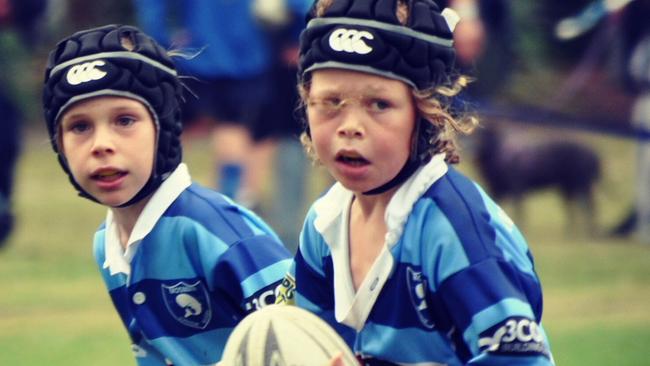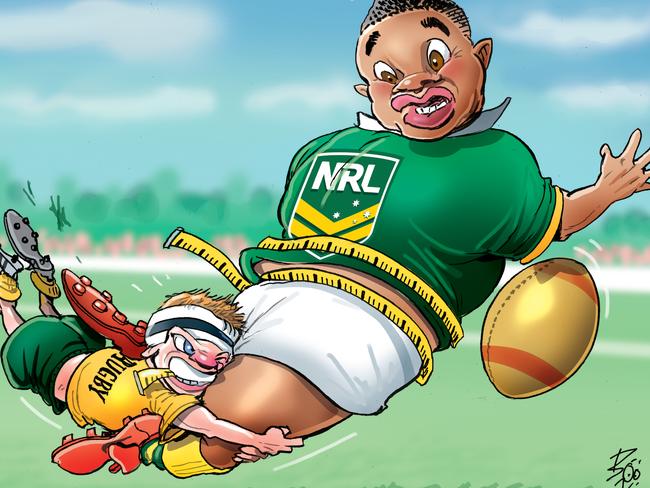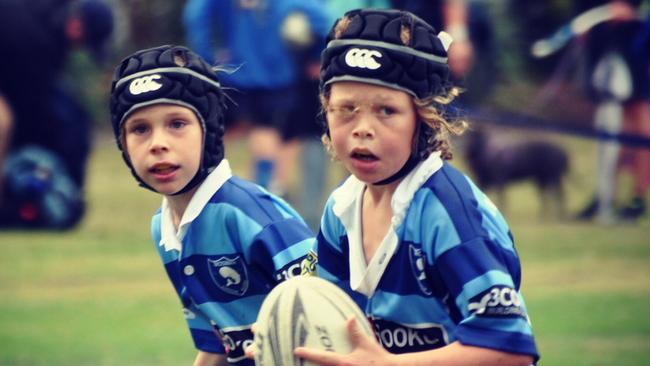Rugby’s ‘escalator strategy’ gets the jump on rugby league in weight-or-age debate
RUGBY union’s comprehensive strategy for tackling the problem of weight disparity in children’s footy is leaving rugby league in the shade, writes Jamie Pandaram.

Rugby
Don't miss out on the headlines from Rugby. Followed categories will be added to My News.
IT’S not just weight, and it’s not just age.
Rugby union has taken the lead in confronting the biggest issue in collision contact sports; how to grow the game at junior level when parents are pulling their children out due to huge size disparities between players.
As Russell Crowe wrote on this page last week, rugby league is standing still on the issue.
And now, union has unveiled its escalator strategy; a commonsense, multi-layered approach to tackling the tricky subject.
Weight will be considered. Age will be considered.
RUGBY REVOLUTION: Solving weight-or-age debate
But also, emotional maturity, and general playing ability will be factored in by independent coaches before deciding whether a child should move up or down a grade.
So far in this debate, there have been the two extremes.
Those in favour of change say it must happen because having children take on rivals more than 20kg heavier will cause severe injuries and result in more leaving the game.

Those against argue its grossly unfair to the bigger children who don’t have emotional maturity to be forced to play alongside older children, and again they’ll be lost to the game.
But with two years of research undertaken by the Australian Catholic University and alongside Sydney juniors and the Brumbies, Rugby Australia’s new policy accounts for those concerns.
You’ll have cases where a 70kg boy is playing against 50kg rivals, but is a teddy bear, rarely breaking the line or scoring five tries a game. It would be unjust to force him to move up and play against older boys.
Then you might have a 65kg boy carving up 50kg rivals, showing superior strength and speed, who would be far better suited to moving up and testing his competitive streak against older boys.
The independent coaches can make these calls using common sense and astute judgment.
On the rare occasion that a large, dominant boy is playing alongside his best mates and doesn’t want to move, you force them to because in the overall picture, you may lose one player as opposed to many from rival teams.
And for the larger child who spends weekends running through smaller opponents, there is no long-term benefit.
They get the fleeting sense of success, but are not developing as players. By the time others catch up in weight and height, and they can no longer trample over opponents, their unevolved skills will fall short.
And this issue is all about player retention in the junior ranks and beyond.
RA’s policy starts this year and applies to players from under-10s to under-15s.
New Zealand rugby has had the system in place for years, and they have still consistently produced the best players in the world of every shape and size.
That’s because the small, fast players hone their talents against similarly-skilled opponents, having to become faster and better steppers to prevail.

At the same time, bigger children can’t simply run over the top of players their own size, so must learn how to run better angles, and develop off-loads and footwork at the line to stand out.
When they all get to open-age levels and mix in the same teams, they’re brimming with confidence and ability they would not have developed as rapidly.
The tackling technique of smaller against bigger players has also come into focus, and it is true that exposing them at a younger age will help them learn and potentially remove some of the fear factor.
But at what cost to player retention?
As players get older and stronger, they naturally want to test their defence against larger opponents.
At the same time, Allan Langer, Benji Marshall and David Campese were never chosen to tackle, but because they were able to produce plays others simply couldn’t.
Good coaches know how to harness the attacking skills of these players while preserving them in defence. You need those players - no football fan buys tickets to watch Lionel Messi or Cristiano Ronaldo make tackles.
Rugby has made a major leap forward with their announcement on Saturday.
In comparison, league has failed to act. They have dithered, they’ve failed to be decisive, and they will pay the price Crowe has warned of.
NSW Rugby League introduced weight-for-age competitions last year but because they were optional, clubs chose not to participate.
BJ Mather, NSWRL’s general manager of football, told this newspaper last week that the lack of interest was most disappointing because it could open up the game to whole new group of young players.
Most parents will also find it difficult to definitively ban their child from playing a particular sport. More often, the children themselves are deciding it is too intimidating, not fun. They’ll make the decision to quit.
Given most sports count primary school clinics in their participation figures, it’s impossible to get accurate numbers on how many people are actively playing the different codes.
But anecdotal and visual evidence says that a large number of traditional league and union families have migrated their children to Aussie rules, deemed as a safer option with less impact.
Union will today be a genuine option for parents whose league-playing children turn around and say they no longer enjoy the game.
Originally published as Rugby’s ‘escalator strategy’ gets the jump on rugby league in weight-or-age debate


